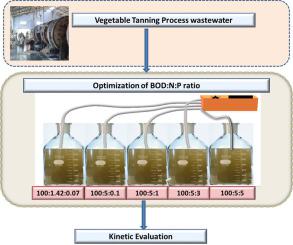Environmental Technology & Innovation ( IF 6.7 ) Pub Date : 2021-07-07 , DOI: 10.1016/j.eti.2021.101776 Abirami Balakrishnan 1 , Sri Bala Kameswari Kanchinadham 1 , Chitra Kalyanaraman 1

|
Biological wastewater treatment methods are extensively used in the treatment of industrial effluents among which Activated Sludge Process (ASP) holds a prominent position. To carry out the degradation of organic matter, the micro-organisms present in the activated sludge need sufficient amount of nutrients and oxygen in the aerobic treatment process. Hence, this study was undertaken to assess and optimize the nutrient requirement in the treatment of vegetable tanning process wastewater (VTW) generated from tanneries. The characterization of VTW revealed that the observed Biochemical Oxygen Demand (BOD):Nitrogen (N):Phosphorus (P) ratio of VTW was 100:1.42:0.07, which is deficient in both N and P. Aerobic reactor study was conducted with BOD:N:P ratio of 100:1.42:0.07, 100:5:0.1, 100:5:1, 100:5:3 and 100:5:5 separately. For N:P of 5:0.1, removal efficiencies of BOD5 , COD and tannin were 49.0 %, 37.3 % and 30.2 %, respectively, whereas, for N:P of 5:3, BOD5,COD and tannin removal efficiency was 59.7 %, 50.9 % and 38.0 %, respectively. However, further increasing the N:P ratio to 5:5, BOD5,COD and tannin removal efficiencies were 60.9 %, 51.2 % and 38.7 %, respectively. It was observed from the results that for N:P ratio of 5:3 to 5:5, the improvement in removal efficiencies was marginal. Hence, BOD:N:P ratio of 100:5:3 was considered as optimum Respirometry study revealed that oxygen uptake was 62.5 mg during the 24 h and 18 % of MLSS growth was observed. From modified Stover-Kincannon model the kinetic constants U of 3.74 g/L day and K of 54.08 g/L.d were arrived at; The k value was obtained from first order and zero order equation was 16.95 mg/L h−1 and 0.026 h−1, respectively for tannin as substrate for the optimized ratio BOD:N:P ratio of 100:5:3. This study emphasizes that proper balance of N and P is needed for synthesis of sufficient biomass for degradation in biological treatment.
中文翻译:

含鞣质制革废水的养分要求
生物废水处理方法广泛用于工业废水的处理,其中活性污泥法(ASP)占有突出地位。为了进行有机物的降解,活性污泥中存在的微生物在好氧处理过程中需要足量的养分和氧气。因此,本研究旨在评估和优化制革厂产生的植鞣工艺废水 (VTW) 处理过程中的营养需求。VTW 的表征表明,观察到的 VTW 的生化需氧量 (BOD):氮 (N):磷 (P) 比为 100:1.42:0.07,N 和 P 均不足。 好氧反应器研究是用 BOD 进行的:N:P 比例分别为 100:1.42:0.07、100:5:0.1、100:5:1、100:5:3 和 100:5:5。对于 5:0.1 的 N:P,如图5所示,COD和单宁分别为49.0%、37.3%和30.2%,而当N:P为5:3时,BOD 5、COD和单宁去除效率分别为59.7%、50.9%和38.0%。然而,进一步将 N:P 比提高到 5:5,BOD 5、COD 和单宁的去除效率分别为 60.9%、51.2% 和 38.7%。从结果可以看出,对于 5:3 到 5:5 的 N:P 比,去除效率的提高是微不足道的。因此,BOD:N:P 比率为 100:5:3 被认为是最佳呼吸测量研究表明,摄氧量为 62.5 mg在 24 小时内观察到 18% 的 MLSS 增长。从修正的 Stover-Kincannon 模型得到动力学常数 U 3.74 g/L 天和 K达到 54.08 g/Ld;k 值从一阶方程和零阶方程获得,分别为16.95 mg/L h -1和 0.026 h -1,对于作为底物的单宁,优化的 BOD:N:P 比率为 100:5:3。该研究强调,在生物处理中合成足够的生物质以进行降解需要适当平衡 N 和 P。











































 京公网安备 11010802027423号
京公网安备 11010802027423号